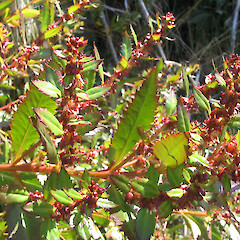Haloragis erecta subsp. erecta
Common name
toatoa, fire weed, shrubby haloragis
Synonyms
Cercodia erecta Murray, Haloragis colensoi Skottsb.
Family
Haloragaceae
Flora category
Vascular – Native
Endemic taxon
Yes
Endemic genus
No
Endemic family
No
Structural class
Herbs - Dicotyledons other than Composites
NVS code
The National Vegetation Survey (NVS) Databank is a physical archive and electronic databank containing records of over 94,000 vegetation survey plots - including data from over 19,000 permanent plots. NVS maintains a standard set of species code abbreviations that correspond to standard scientific plant names from the Ngä Tipu o Aotearoa - New Zealand Plants database.
HALESE
Chromosome number
2n = 14
Current conservation status
The conservation status of all known New Zealand vascular plant taxa at the rank of species and below were reassessed in 2017 using the New Zealand Threat Classification System (NZTCS) – more information about this can be found on the NZTCS website. This report includes a statistical summary and brief notes on changes since 2012 and replaces all previous NZTCS lists for vascular plants.
Please note, threat classifications are often suggested by authors when publications fall between NZTCS assessment periods – an interim threat classification status has not been assessed by the NZTCS panel.
- Conservation status of New Zealand indigenous vascular plants, 2017 . 2018. Peter J. de Lange, Jeremy R. Rolfe, John W. Barkla, Shannel P. Courtney, Paul D. Champion, Leon R. Perrie, Sarah M. Beadel, Kerry A. Ford, Ilse Breitwieser, Ines Schönberger, Rowan Hindmarsh-Walls, Peter B. Heenan and Kate Ladley. Department of Conservation. Source: NZTCS and licensed by DOC for reuse under the Creative Commons Attribution 4.0 International licence.
2017 | Not Threatened
Previous conservation statuses
2012 | Not Threatened
2009 | Not Threatened
2004 | Not Threatened
Distribution
Endemic. New Zealand: Kermadec, North, South, Stewart and Chatham Islands.
Habitat
Coastal to montane in forest or scrub. Often on slip scars or colonising recently cleared ground. Often appearing following fire (hence one of the common names).
Wetland plant indicator status rating
Information derived from the revised national wetland plant list prepared to assist councils in delineating and monitoring wetlands (Clarkson et al., 2021 Manaaki Whenua – Landcare Research Contract Report LC3975 for Hawke’s Bay Regional Council). The national plant list categorises plants by the extent to which they are found in wetlands and not ‘drylands’. The indicator status ratings are OBL (obligate wetland), FACW (facultative wetland), FAC (facultative), FACU (facultative upland), and UPL (obligate upland). If you have suggestions for the Wetland Indicator Status Rating, please contact: [Enable JavaScript to view protected content]
FACU: Facultative Upland
Occasionally is a hydrophyte but usually occurs in uplands (non-wetlands).
Detailed description
Perennial herb or subshrub. Stems to c.1 m tall, decumbent to erect, freely branching, 4-angled, glabrous or scabrid. Leaves opposite. Petiole (0.2)-0.5-1.7-(3) cm long. Lamina (12-)15-70(-90) × (3-)-5-25-(-35) mm, lanceolate to elliptic or oblong-elliptic, strongly serrate with teeth to 4 mm long, glabrous or scabridulous; lateral veins obscure; base cuneate to truncate. Dichasia of 3-7 flowers; primary bracts ± serrate. Pedicels 0.5-0.6 mm long, to 1 mm at fruiting, deflexed until anthesis. Flowers 4-merous, often reddish. Sepals 0.8-1.2 mm long, deltoid, erect, persistent. Petals 1.5-.0(-2.5) mm long. Stamens 8. Anthers 1.2-1.7 mm long, oblong, red or yellow, the inner < outer. Ovary 4-celled, ribbed. Stigmas ± pink. Fruit 1.8-3.0 × 1.5-2.5(-4.0) mm (including the usually present, variable, deltoid wings), usually ovoid, rugose or smooth between ribs or wings.
Similar taxa
None. The Surville Cliffs endemic H. erecta subsp. cartilaginea (Cheeseman) Orchard is scarcely any different. The main differences are its decumbent rather than erect habit and orbicular to broad-ovate leaves. In cultivation plants of this subspecies often become suberect, laxer, and the leaves less harshly scabrid.
Flowering
Throughout the year
Flower colours
Red/Pink, Yellow
Fruiting
Throughout the year
Life cycle
Fruit are wind dispersed (Thorsen et al., 2009)
Propagation technique
Easily grown from fresh seed and by cuttings. A somewhat weedy species which often appears following disturbance within forest and scrub, and which can at times appear within unkept gardens and wasteland within urban areas. Some forms are dark purple-red or maroon in colour.
Etymology
haloragis: Salt grapes
erecta: Erect
Where To Buy
Not commercially available.
Attribution
Fact sheet prepared for NZPCN by P.J. de Lange (3 November 2005). Description based on Webb et al. (1988) and observations made from fresh material.
References and further reading
Cunningham, A. 1839: Florae insularum Novae Zelandiae precu rsor; or a specimen of the botany of the islands of New Zealand. Annals of Natural History 3: 29-34. Moorfield, J. C. (2005). Te aka : Maori-English, English-Maori dictionary and index. Pearson Longman: Auckland, N.Z. Orchard, A.E. 1975: Taxonomic Revisions in the Family Haloragaceae. I. The Genera Haloragis, Haloragodendron, Glischrocaryon, Meziella and Gonocarpus. Bull.Auckland Inst.Mus. 10: 1-299. Thorsen, M. J.; Dickinson, K. J. M.; Seddon, P. J. 2009. Seed dispersal systems in the New Zealand flora. Perspectives in Plant Ecology, Evolution and Systematics 11: 285-309
Webb, C. J.; Sykes, W. R.; Garnock-Jones, P. J. 1988: Flora of New Zealand. Vol. IV. Naturalised Pteridophytes, Gymnosperms, Dicotyledons. Christchurch, New Zealand, Botany Division, D.S.I.R.
NZPCN Fact Sheet citation
Please cite as: de Lange, P.J. (Year at time of access): Haloragis erecta subsp. erecta Fact Sheet (content continuously updated). New Zealand Plant Conservation Network. https://www.nzpcn.org.nz/flora/species/haloragis-erecta-subsp-erecta/ (Date website was queried)








